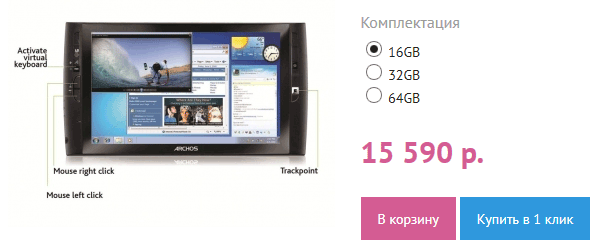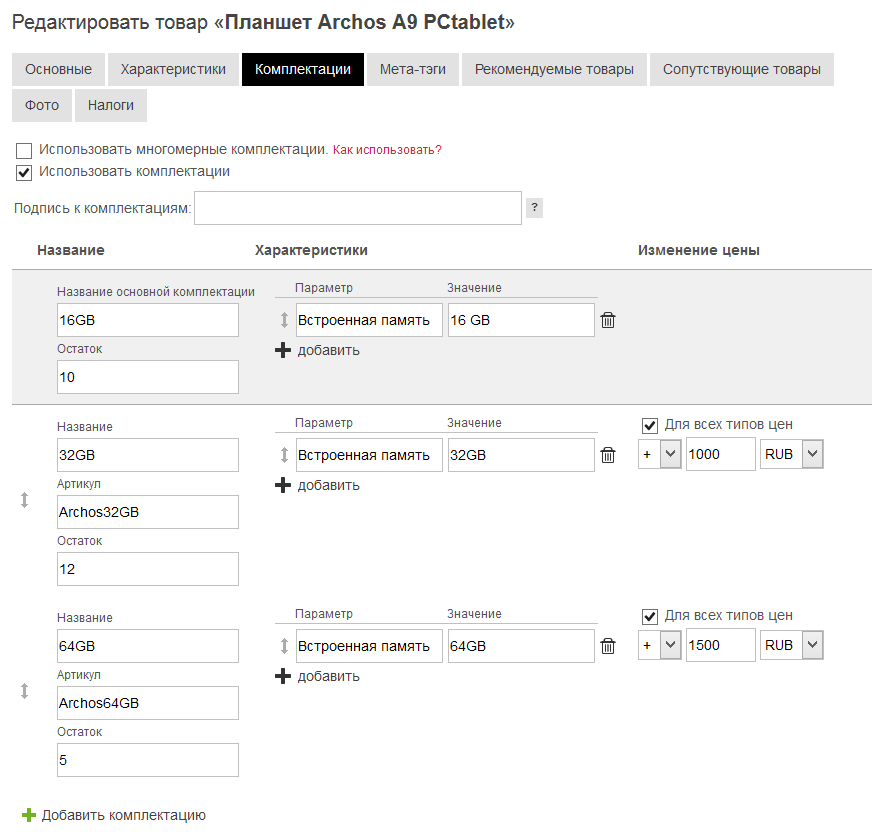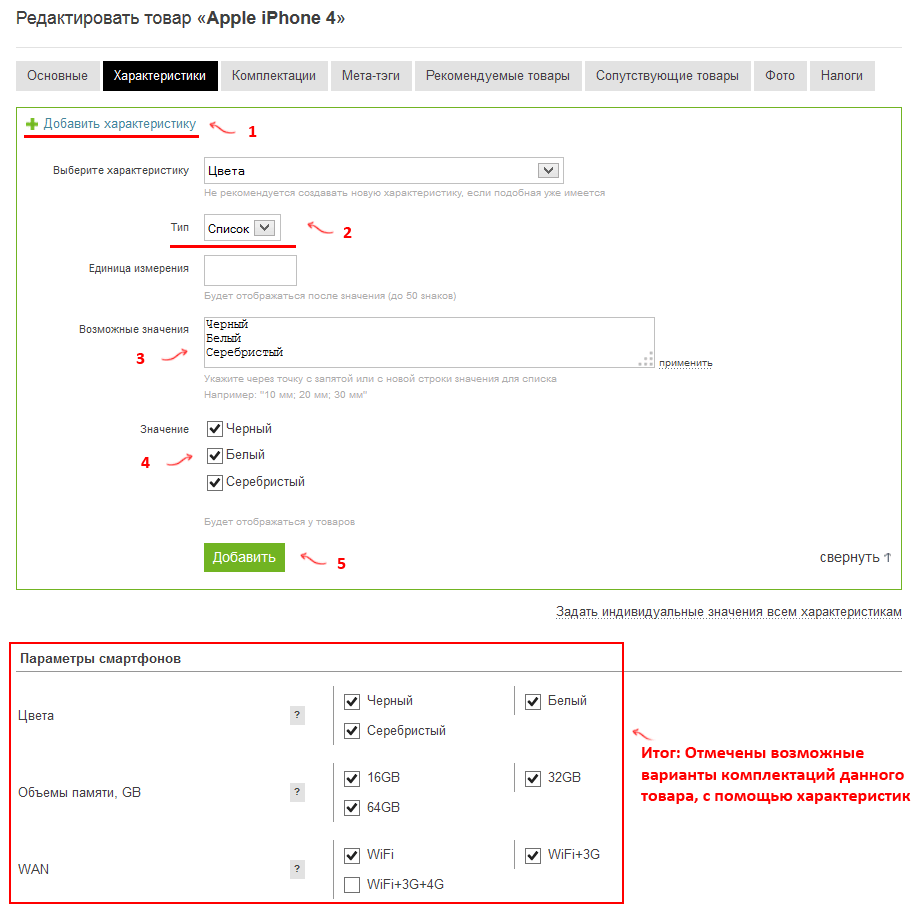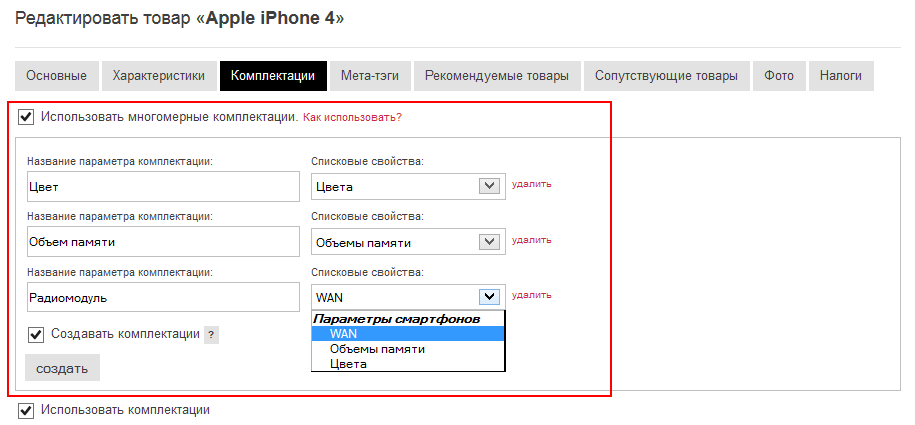Implementation of complete sets of goods in online stores ReadyScript
Support for bundled goods today is one of the most sought-after features among owners of online stores. Complete sets allow combining products with slight differences (for example: color, size, memory size, ...). Various properties are presented for goods in the form of separate parameters that can be selected before placing an order.

In this article, we will talk about the trim levels and how they are implemented in the ReadyScript online store platform .
So, the bundle of goods (sometimes also called Product offers) can be of two types: simple and multidimensional . Consider each of the types in more detail.
They are defined in the form of a flat list, and are always displayed in the product card with one parameter. For example, this:

Complete sets are inextricably linked with goods, therefore they are configured on a separate tab in the product card of the administrative panel.

Each complete set contains the following information:
For the “default configuration” (it will always be the first in the list, highlighted in gray) The Article and Prices are used from the “main” product tab. Information of other configurations, if selected, overload the standard information of the goods and fall into the order.
The thing is that after the introduction of complete sets, a lot of goods are now described in one nomenclature position. And it became unclear how to display the goods in the lists. At what price? What characteristics? The solution to this problem was the introduction of the concept of "default configuration", the information of which will be used if you want to show the goods in the list.
As a “default configuration,” we recommend that you use a variation of the product with the lowest price. This will additionally attract potential buyers while viewing the product category, as well as ensure the display of goods at a lower filter value at a price, if installed by the user.
Simple configurations are present in 1C Trade Management and are called “Item Features”. 1C UT allows you to maintain individual prices and accounting for balances in the context of goods with different nomenclature characteristics. For example, you can indicate that T-shirts are blue, sizes S, M, L - 5 pcs. and they cost 100 p., and green T-shirts, sizes M, L - 2 pcs. and they cost 120 p. This model integrates perfectly with the architecture of the complete sets in ReadyScript. During data exchange, everything related to the characteristics of the product range is transferred to the online store.
On the Internet, there are many instructions for setting up “Item Specifications” for various versions of 1C UT, so we will not consider this issue in detail in this article.
Simple bundles are great for products with one parameter. If there are at least two parameters, there is a problem with their presentation on the site. For example, if you sell clothes that have two parameters: color and size, then you need to create flat configurations of the following type:
S_White
M_White
L_White
S_Black
...
L_Green
There is an alternative option, you can wind up goods of different colors in separate positions, and put the size in the package. Both options, in our opinion, are equally inconvenient for both users and store owners, so we have developed the functionality of “multidimensional configurations”.
They allow you to create several parameters for the product, which the buyer can choose when placing the product in the basket. It looks like this:

Consider the process of setting up multidimensional configurations for goods step by step:
It was not without reason that we made multidimensional configurations as an add-on for simple configurations. The reason for this was the lack of such a thing as multidimensional configurations in 1C.
In this implementation, integration is achieved as follows:
Simple and multi-dimensional configurations allow users to easily organize the sale of goods with parameters. The positive effect of using trim levels is obvious. For administrators, this is a significantly optimized inventory base; for buyers, this is a completely different level of product navigation when similar products are presented on one page.

In this article, we will talk about the trim levels and how they are implemented in the ReadyScript online store platform .
So, the bundle of goods (sometimes also called Product offers) can be of two types: simple and multidimensional . Consider each of the types in more detail.
Simple picking
They are defined in the form of a flat list, and are always displayed in the product card with one parameter. For example, this:

Complete sets are inextricably linked with goods, therefore they are configured on a separate tab in the product card of the administrative panel.

Each complete set contains the following information:
- Personal characteristics for configuration
Users will see them on the website in the general list of characteristics, after choosing a configuration - Prices
If several types of prices are set in the system, then it is possible to set several prices for each configuration by unchecking the box “For all types of prices” - Item number
You can set each item number as your item, this item will be displayed in the order - The remainder
For the “default configuration” (it will always be the first in the list, highlighted in gray) The Article and Prices are used from the “main” product tab. Information of other configurations, if selected, overload the standard information of the goods and fall into the order.
What is the “default equipment” and why is it highlighted among others?
The thing is that after the introduction of complete sets, a lot of goods are now described in one nomenclature position. And it became unclear how to display the goods in the lists. At what price? What characteristics? The solution to this problem was the introduction of the concept of "default configuration", the information of which will be used if you want to show the goods in the list.
As a “default configuration,” we recommend that you use a variation of the product with the lowest price. This will additionally attract potential buyers while viewing the product category, as well as ensure the display of goods at a lower filter value at a price, if installed by the user.
Integration of simple configurations with 1C
Simple configurations are present in 1C Trade Management and are called “Item Features”. 1C UT allows you to maintain individual prices and accounting for balances in the context of goods with different nomenclature characteristics. For example, you can indicate that T-shirts are blue, sizes S, M, L - 5 pcs. and they cost 100 p., and green T-shirts, sizes M, L - 2 pcs. and they cost 120 p. This model integrates perfectly with the architecture of the complete sets in ReadyScript. During data exchange, everything related to the characteristics of the product range is transferred to the online store.
On the Internet, there are many instructions for setting up “Item Specifications” for various versions of 1C UT, so we will not consider this issue in detail in this article.
Limitations of Simple Options
Simple bundles are great for products with one parameter. If there are at least two parameters, there is a problem with their presentation on the site. For example, if you sell clothes that have two parameters: color and size, then you need to create flat configurations of the following type:
S_White
M_White
L_White
S_Black
...
L_Green
There is an alternative option, you can wind up goods of different colors in separate positions, and put the size in the package. Both options, in our opinion, are equally inconvenient for both users and store owners, so we have developed the functionality of “multidimensional configurations”.
Multidimensional configuration
They allow you to create several parameters for the product, which the buyer can choose when placing the product in the basket. It looks like this:

Consider the process of setting up multidimensional configurations for goods step by step:
- Each parameter of the future multidimensional configuration is a list that is associated with one of the Characteristics. The product must have at least two list characteristics specified, otherwise the use of multidimensional configurations will be impossible.

This approach allows you to achieve two goals at once:- Preparation of information for multi-dimensional configurations, using the standard tool “Features”, which is well integrated with 1C
- The product will be given useful characteristics that can be used for various purposes in the system, for example, to filter products
- After the list characteristics are set, you need to go to the “Options” tab, enable the use of multidimensional configurations and add parameters. For each parameter, you can specify a name and select the characteristic with which it is associated. The system itself will offer a list of characteristics, based on data from the tab “Characteristics”.

If there is a need to indicate an individual price, article or balance for any combination of parameters, you must select the "Create complete sets" checkbox. In this case, simple configurations will be generated, from which you can specify individual information.
If you do not use simple configurations in conjunction with multidimensional ones, then the parameters will be displayed in the product card, but when changing their values, the price, article and balance will not change. The parameters chosen by the buyer will be recorded in the order.
How do multi-dimensional configurations integrate with 1C?
It was not without reason that we made multidimensional configurations as an add-on for simple configurations. The reason for this was the lack of such a thing as multidimensional configurations in 1C.
In this implementation, integration is achieved as follows:
- In 1C, the goods must have properties (they are “Characteristics” in ReadyScript) and characteristics of the nomenclature (they are “Options” in ReadyScript)
- The usual data exchange between the site and 1C is configured
- After unloading goods from 1C to the site, you need to set multidimensional configuration parameters for goods in the administration panel of the online store, for example, using mass installation
Conclusion
Simple and multi-dimensional configurations allow users to easily organize the sale of goods with parameters. The positive effect of using trim levels is obvious. For administrators, this is a significantly optimized inventory base; for buyers, this is a completely different level of product navigation when similar products are presented on one page.
